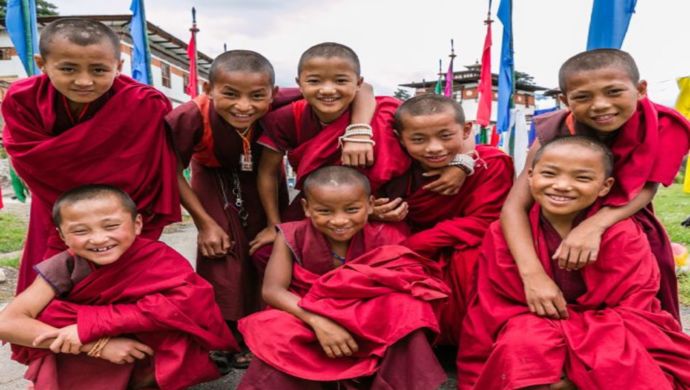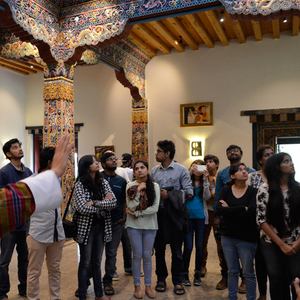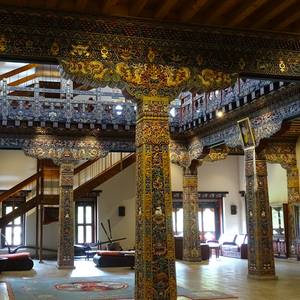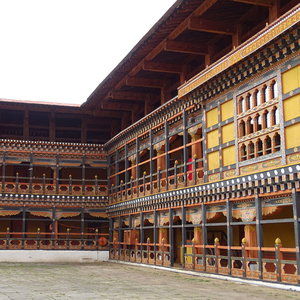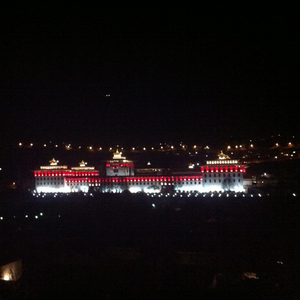Day 1. Paro - Thimphu:
Driving Distance: 65 Kms, Driving time: 1.50 hrs – 2 hrs., Altitude of Thimphu: 2,350 m
Your flight to Paro on a clear day, is marked with the panoramic views of the Himalayas including the Everest and other famous Peaks. The approach through the foothills and the landing (including few steep turns) at the tiny airstrip of Paro has been termed as adventurous by many travelers. After the completion of immigration formalities at the Paro Airport exit door, you will be received by your Bhutanese guide with traditional “Tashi Khadar”. Afterwards drive to Thimphu following the Pa Chhu River. Check-In to the hotel and have your first experience with Bhutanese Cuisine. Rest of the day is at leisure. You can explore the Thimphu valley and town or shop till your heart’s content. Interaction with a Local Bhutanese Architect over the dinner and learn more about Bhutanese Architecture.
Meals – Lunch and Dinner; Overnight at the Hotel in Thimphu.
Day 2. Thimphu Sightseeing:
Today you would be driven in and around Thimphu covering key places of interest. After breakfast you would visit
- Kuensel Phodrang, the gigantic Buddha Dordenma Statue located atop a hill in Kuensel Phodrang Nature Park.
- National Memorial Chhorten, a Stupa built in 1974 to honor the third Druk Gyalpo, Jigme Dorji Wangchuck. Every morning till night old people and young people circumambulate the Chhorten. It is build in Tibetan Style pattern on design of Classical Stupa. The Chhorten depicts images of wrathful deities with their female consorts. You may choose to light butter lamps and also circumambulate around the Chorten.
- Zorig Chusom, Premier institute of traditional arts and crafts in Thimphu built of preserve “thirteen arts and crafts of Bhutan”.
- Folk Heritage, traditional house giving an insight to the Bhutanese lifestyle, and artifacts from the rural households
Thereafter you would be taken to a local restaurant for lunch. In the afternoon you would be taken to
- Changangkha Monastery, popular fortress like temple perched on a ridge above Central Thimphu built in 15th Century by Lama Phajo Drugom Zhipo. The Lhakhang houses Chenresig: an 11-headed, thousand-armed manifestation of Avolokitesawara as the central statue.
- Tashichhodzong, or ‘the fortress of the glorious religion’. Initially erected in 1641 by Shabdrung Ngawang Namgyal, it was rebuilt in the 1960s during the reign of Bhutan’s third king in the traditional style, without plans or nails. It houses some ministries, His Majesty’s secretariat, and the central monk body and opens after 5 PM. As you enter the building, you will come across four beautiful sculptures of the Guardians of the Four Directions – locally known as Chennizang, the red King of the west; Yulkhorsung, the white king of the east; Namthose, the gold king of the north; and Phagchepo, the blue king of the south. Sculptures of some other divine figures can also be seen near the entry gates. The architecture of the Courtyard having rectangular stone slabs is very impressive. This Dzong is a perfect example of how grand and intricate Bhutanese architecture is.
During the course of sightseeing, you would admire the various architectures of Bhutan in terms of engineering, designing keeping their age old traditions intact. On the completion of sightseeing, you are driven back to your hotel.
After relaxing for sometime you are served with dinner.
Meals – Breakfast, Lunch and Dinner; Overnight at the Hotel in Thimphu.
Day 3. Thimphu - Punakha/Wangdue:
Driving Distance: 76 Kms, Driving time: 2.50 hrs – 3 hrs., Altitude of Punakha: 1310 m
After breakfast and completion of Check Out formalities you are driven to Punakha/Wangdue, for your second leg of the tour. On the way, you would stop at
- Dochula Pass, lies at an elevation of 3,150 m and is a great place to view the higher Himalayas. The landmarks around the pass includes 108 Druk Wangyal Stupas built under the patronage of Queen Ashi Dorji Wangmo Wangchuk. The Chhortens are also an example of Bhutanese unique art and architecture.
After arrival at Punakha, check in to the hotel. Post lunch, you would visit
- Punakha Dzong, built in 1637 by Shabdrung Ngawang Namgyal. For many years until the time of the second King, it served as the seat of the Government. It is still the winter residence of Je-Khenpo (The Chief Abbot of the Central Monastic Body of Bhutan). The Dzong is one of the most impressive Dzongs in Bhutan and is a good example of Bhutanese age old art and Architecture. The Dzong was constructed as an “embodiment of Buddhist values” and was one of the 16 Dzongs built by the Shabdrung during his rule from 1594 to 1691. The materials used in building the Dzong consisted of compacted earth, stones and timber in doors and windows. Inside the Dzong, you would murals depicting life story of Buddha done during the rule of the second Druk Desi. Large gilded statues of Buddha, Guru Rinpoche and Zhabdrung which belong to mid 18th century, and gilded panels on pillars are also here.
- Chhimi Lhakhang, a famous Temple, which is also known as “The Temple of Fertility” built by Lama Drukpa Kuenley. The Lhakhang has a row of prayer wheels and its exterior walls are embedded with slates carved with images of saints. Images of Shabdrung, Sakyamuni Buddha and Chenresig are also deified in the monastery.
- Punakha Suspension Bridge, one of the longest suspension bridge in Bhutan. The bridge is high on mountain river and is perfect for those who wish to get their heart pumping with excitement. It connects the town of Punakha and the Punakha Dzong with the smaller villages surrounding the Punakha town. The view from the bridge is very stunning and spectacular. The bridge is a unique example of Bhutanese Architecture.
After the completion of sightseeing, you are driven back to your hotel.
Meals – Breakfast, Lunch and Dinner; Overnight at the Hotel in Punakha/Wangdue.
Day 4. Punakha/Wangdue - Paro:
Driving Distance: 135 Kms, Driving time: 4.50 hrs. – 5 hrs., Altitude of Paro: 2,280 m
After breakfast, you would check out of the hotel to proceed to Paro, final leg of the tour. On the way stop at Tamchog Lhakhang;
- Tamchog Lhakhang (between Paro and Thimphu); built in the 13th century by Thangtong Gyalpo. He is also known as the Iron bridge builder. Situated on a hill top, we have to cross an ancient style bridge to reach the temple. It is owned by the descendants of Thangtong Gyalpo.
After arriving at Paro, you would be transferred to you Hotel for Check In. Post lunch, you would be taken around to visit
- Paro Rimpung Dzong, also known as Fortress of the heap of jewels, built during the time of Shabdrung Ngawang Namgyal in 1646. It is one of the finest example of Bhutanese Architecture. Here you can see intricate wood work, large beams fitted into each other and held together without nails. The Tower of the Dzong is one of the most beautiful in Bhutan with its magnificent wood work.
- Ta Dzong, an ancient watch tower overlooking Rimpung Dzong built in 1951 now converted into national museum. The round building is said to be in the shape of a conch shell. It has 2.5m-thick walls and was completed in 1656. Inside you can see Thangkas (Tibetan Buddhist painting on cotton, or silk usually depicting a Buddhist deity, scene, or mandala) depicting important saints and preachers.
Later you are driven back to the Hotel. Evening is free for leisure activities and shopping around the Paro Town.
Meals – Breakfast, Lunch and Dinner; Overnight at the Hotel in Paro.
Day 5. Paro Sightseeing:
After breakfast, start your day with a hike to
- Taktsang Monastery (Tiger's nest), the abode of gods and monks situated at an altitude of 3100m on the Upper Paro Valley, Bhutan. As per the legend, Guru Padmasambhana (Guru Rinpoche), the tantrum mystic who brought Buddhism to Bhutan, came in the form of Dorje Droloe riding a flying tigress to subdue the demon that was obstructing the spread of Buddhism in the Himalayas. After the completion of the hike, you would be served picnic Lunch among the woods. The monastery is so precariously perched that it is said: "it clings to the side of the mountain like a gecko". What is remarkable about Taktsang is the variation of the four temples that appear different from one another. One of these is said to be the famous spot for the three-month meditation of Guru Rinpoche and the birthplace of one of the leading lamas.
After lunch, visit
- Amankora or Hotel Zhiwaling (whichever possible). Though both of them are hotels, but their intricate designs and adherence to local Bhutanese tradition during the construction period is worthy of being seen
You would then visit a Traditional Bhutanese village house to study the Art and architecture of Bhutan at old times. The visit shall give you a good insight into the way of life in villages in Bhutan. Finally, be driven back to your hotel.
Meals – Breakfast, Lunch and Dinner; Overnight at the Hotel in Paro.
Day 6. Departure:
Today we will bid farewell to this beautiful country and take an early flight back. We hope by now you mist have made some good friends and also have taken photographs and beautiful memories of Bhutan. We certainly hope of serving you again on your next visit to this great country or the Last Shangri-La. Tashi Delek.
